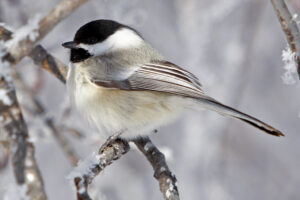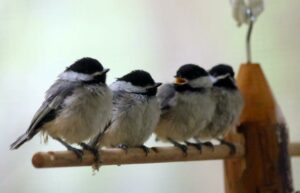
Black-capped Chickadee: A Different Meaning to Bird Brain

“Bird brain” is a term many have heard used to describe someone as stupid, foolish, or tiny-brained. Ironically, it is “bird-brained” to use this phrase since, in reality, bird’s brains are pretty intricate and fascinating. Take the Black-capped Chickadee, for example; researchers have evaluated these small songbirds’ brains for the past thirty years because of their capability to kill old neurons and regenerate new ones. This is known as neurogenesis. Neurogenesis primarily occurs in the hippocampus, an area of the brain in the temporal lobe responsible for learning and storing memories. So why is neurogenesis in Black-capped Chickadees so unique? As we age, neurogenesis slows down in our brains, and in some studies, researchers believe it is completely undetectable in the hippocampus as we become adults. This means that as we age, it is harder for our brains to learn and store memories. However, in Black-capped Chickadees, neurogenesis in the hippocampus occurs throughout their lifespan and even increases during certain times of the year!
Over the last three decades, studies have been conducted on Black-capped Chickadees, with each of these studies concluding that during the fall, specifically in October, when their diet changes from eating insects and occasionally berries to a mainly seed diet, their hippocampus becomes enlarged. When the hippocampus becomes enlarged, longer-lasting spatial memory occurs. This increase in the hippocampus volume during the fall is due to Black-capped Chickadees needing to cache seed for later use when food sources are scarce. Caching is a relatively common survival technique in the bird world, where birds will hide food in numerous places to eventually come back to later. Black-capped Chickadee individuals have been observed caching over 100,000 items in a given year, with roughly 80,000 items being cached during the fall! Even more impressive is that they can remember hundreds of cache locations for up to 28 days. Prior to caching, they will make things easier for themselves when they are ready to feast by de-shelling seeds and removing wings on insects and the heads of larvae. They hide these items under bark, tucked away in branches, or stuffed into crevices. Once spring has arrived, their brain kills off the neurons responsible for remembering these caches and creates new neurons.
Besides neurogenesis occurring due to seasonal changes, researchers believe it also occurs in their environment and social structure. Although there is not much information out there on whether neurogenesis actually occurs with non-seasonal environmental changes, the fact that Black-capped Chickadees will permanently alter their feeding techniques or territory locations due to a new predator in the area or a change in their food source suggests that neurogenesis may be happening in those instances as well. Another situation in which neurogenesis may occur is when Black-capped Chickadees who are not successful with finding food will alter their techniques if they watch another individual’s success at finding food. The unsuccessful chickadee adapts to the successful chickadees’ food-finding skills, never using their old technique again.

Social structure adaptation has been observed when a mating pair ends their bond. Although Black-capped Chickadees are monogamous, another more dominant suitor occasionally swoops in and replaces the less dominant mate. Studies have observed that the bond between the previous mates changes. For example, previously paired chickadees have been observed to avoid a feeding area, whether permanently or during certain times of the day, if their ex-mate also feeds in that area. Within this same study, as fall approached and chickadees began to flock together, the previous pair seemed to no longer recognize each other, theorizing that their brains had killed off the neurons associated with that previous mate and replaced them with new neurons associated with their current partner.
With several decades of research and observation, scientists are beginning to understand how Black-capped Chickadee’s brains function. They hope we will soon understand how neurogenesis occurs throughout a chickadee’s lifetime within their hippocampus. By determining how neurogenesis works throughout the lifespan within the hippocampus of Black-capped Chickadees, scientists hope we can replicate this in adult human brains. If we can make this possible, Alzheimer’s, Dementia, and even Parkinson’s Disease can potentially be a thing of the past, and the term “Bird Brain” will be used for intelligence, the ability to store and retain memories, and adaptability rather than stupidity.
Thank you to the following sources for the information for this post:
- https://www.pnas.org/doi/epdf/10.1073/pnas.91.23.11217
- Understanding hippocampal neural plasticity in captivity: Unique contributions of spatial specialists | Learning & Behavior (springer.com)
- To Remember Seed Caches, Bird Grows New Brain Cells – The New York Times (nytimes.com)
- https://www.researchgate.net/profile/Vladimir-Pravosudov/publication/275256416_Environmental_Influences_on_Spatial_Memory_and_the_Hippocampus_in_Food-Caching_Chickadees/links/5696cef708aea2d743748a0f/Environmental-Influences-on-Spatial-Memory-and-the-Hippocampus-in-Food-Caching-Chickadees.pdf
- Old and New Memories of Black-capped Chickadees | BirdNote
- Hoshooley JS, Sherry DF (2004) Neuron production, neuron number, and structure size are seasonally stable in the hippocampus of the food-storing black-capped chickadee (Poecile atricapillus). Behav Neurosci 118:345–355.
- Total recall: A brilliant memory helps chickadees survive | Knowable Magazine
- Black-capped chickadees astonishing secrets – DNR News Releases (iowadnr.gov)
- *An Analysis of Flock Organization in Black-Capped Chickadees (usu.edu)
- Birth of New Neurons in the Human Hippocampus Ends in Childhood | UC San Francisco (ucsf.edu)
- JCI – Can Parkinson’s disease be cured by stimulating neurogenesis?